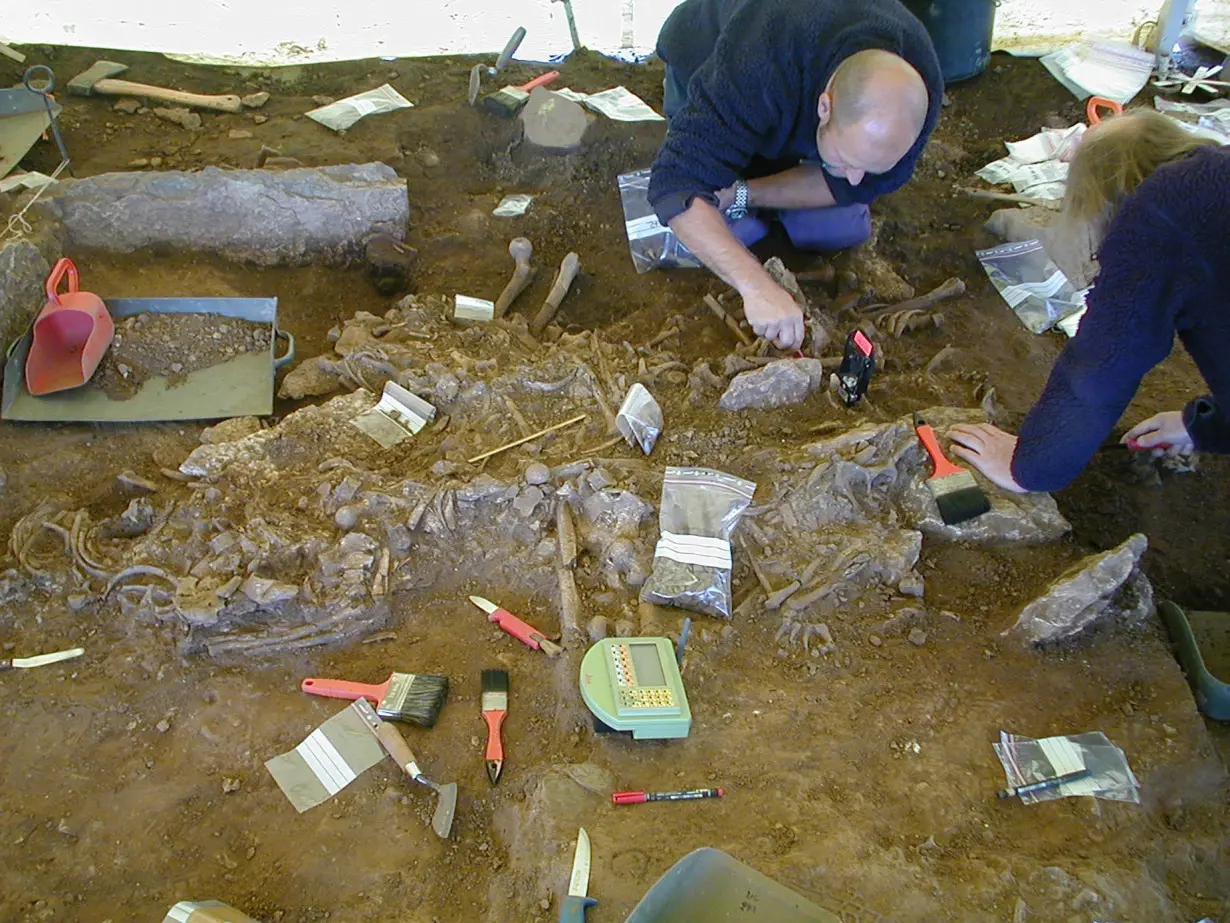(CNN) — The oldest known plague victims date back to around 5,000 years ago in Europe. But it’s never been clear whether two cases, one in Latvia and one in Sweden, were isolated and sporadic or evidence of a wider outbreak.
A new study, based on ancient DNA recovered from 108 prehistoric individuals unearthed at nine grave sites in Sweden and Denmark, suggests that an ancient form of the plague might have been widespread among Europe’s first farmers and could explain why this population mysteriously collapsed over the space of 400 years.
“It’s fairly consistent across all of Northern Europe, France and it’s in Sweden, even though there are some quite big differences in the archaeology, we still see the same pattern, they just disappear,” said Frederik Seersholm, a postdoctoral researcher at the Lundbeck Foundation GeoGenetics Centre, Globe Institute, University of Copenhagen in Denmark and lead author of the study published in the journal Nature on Wednesday.
This group, known as Neolithic farmers, migrated from the eastern Mediterranean, replacing small bands of hunter-gatherers and bringing agriculture and a settled lifestyle to northwestern Europe for the first time around 6,000 to 7,000 years ago. Their legacy lives on in the continent’s many megalithic graves and monuments, the most famous of which is Stonehenge.
Archaeologists intensely debate the cause of this population’s disappearance between 5,300 and 4,900 years ago. Some attribute their demise to an agricultural crisis brought on by climate change and others suspect disease.
“All of a sudden, there’s no people getting buried (at these monuments) anymore. And the people who were responsible for building these megaliths (are gone),” Seersholm said.
Violence was unlikely to have played a role, Seersholm said, with the next wave of newcomers, known as the Yamnaya, arriving from the Eurasian steppe after a gap in the archaeological record.
The study found that forms of the bacterium that causes plague were present in 1 in 6 ancient samples, suggesting infection with the disease was not rare.
“These plague cases, they are dated to exactly the time frame where we know the Neolithic decline happened so this is very strong circumstantial evidence that the plague might have been involved in this population collapse,” he said.
Genetic time travel
Genetic information about pathogens can be preserved in human DNA, allowing scientists to time travel to find out about ancient diseases and how they evolved.
Yersinia pestis, the bacteria that causes plague, was the most prevalent of the six pathogens the identified in the new research, present in 18 individuals, or 17% of the 108 sampled.
However, according to the study, the true prevalence of the plague at that time could have been much higher given that ancient DNA can only be extracted from well-preserved human remains. (It’s also not possible to know for sure whether the people studied died of the plague — only that they were infected.)
Nonetheless, the study authors said their findings did not necessarily suggest a swift and deadly plague epidemic. The bacterium was detected in remains from four out of six generations buried at some of the grave sites.
“I was expecting to find that the plague was only present in the last generation, which would be evidence that the plague is killing them all, and that was it,” Seersholm said, who pieced together family trees from the graves using the ancestry information contained in the ancient DNA.
“I was also expecting the plague to be exactly the same, like every single DNA base pair would be the exact same, because that’s what you would expect if you saw a swift outbreak of disease, but that was not what we found,” he said.
Instead, the team found evidence of three distinct infection events, plus different variants of the bacterium that causes plague.
“The big question is, then, how come the plague didn’t just kill everyone in the beginning? And that was also puzzling to us, so we started looking at the genes to see if we could find some sort of explanation,” he said.
The team found instances where plague genes had reshuffled — lost, added or moved around in the DNA sequences — which could perhaps have affected the virulence of the pathogen in the span of a generation.
“It’s in an area of the genome where we know that virulence is coded for, and (that’s) the reason that our hypothesis is that it was more virulent (over the generations),” Seersholm said. “But of course, this is, this is very, very hard to test, because you can’t really just grow an ancient (bacterium).”
Prehistoric plague’s transmission
Given that the remains had been carefully buried in a grave, Seersholm said it is possible that the genetic data examined in the study captured the very beginning of a plague epidemic. It’s also likely that the disease was less severe than the bubonic plague that caused the Black Death, the world’s most devastating plague outbreak that is estimated to have killed half of Europe’s population in the space of seven years during the Middle Ages.
What’s more, because the variants detected in the samples lacked a gene that geneticists know is crucial for the bacterium’s survival in a flea’s digestive tract, the resulting disease was unlikely to be identical to bubonic plague, which was spread by fleas carried by rodents, according to the study. Bubonic plague still exists today, and symptoms include painful, swollen lymph nodes, called buboes, in the groin, armpit or neck areas, as well as fever, chills and coughing.
The study suggests that in Scandinavia at that time, plague was probably being spread human to human rather than by sporadic transmission from animals, although it’s not possible to know how lethal or chronic the disease was, said Mark Thomas, a professor of evolutionary genetics at University College London.
However, Thomas, who wasn’t involved in the latest research but was part of the team that first identified the Neolithic decline, said he’s less convinced that plague was the main reason behind the wider population bust, which he said happened at different times in Europe and was likely a result of a combination of factors, including poor farming practices that exhausted the soil and widespread ill health.
“Neolithic people were very compromised in terms of general health. Their bones look bad,” Thomas said.
“There could have been a more general increase in pathogen load,” he added. However, “from a DNA point of view” Yersinia pestis happens to be one of the diseases more visible to archaeological scientists and thus easier to identify and study.
The-CNN-Wire
™ & © 2024 Cable News Network, Inc., a Warner Bros. Discovery Company. All rights reserved.

 US urges probe into killings of two Mozambique opposition figures
US urges probe into killings of two Mozambique opposition figures
 Canadian minister says offer to appoint mediator in Montreal port dispute rejected
Canadian minister says offer to appoint mediator in Montreal port dispute rejected
 Court decisions in Michigan and North Carolina deny GOP challenges to overseas voters
Court decisions in Michigan and North Carolina deny GOP challenges to overseas voters
 Ukraine blasts U.N.'s Guterres over invitation to BRICS summit in Russia
Ukraine blasts U.N.'s Guterres over invitation to BRICS summit in Russia
 Here's why every Australian can request, and receive, a free portrait of King Charles
Here's why every Australian can request, and receive, a free portrait of King Charles
 Elliott defends Citgo offer in the face of creditors' objections
Elliott defends Citgo offer in the face of creditors' objections
 FTC's rule banning fake online reviews goes into effect
FTC's rule banning fake online reviews goes into effect
 Sapelo Island ferry resumes operations after deadly boat dock gangway collapse
Sapelo Island ferry resumes operations after deadly boat dock gangway collapse
 Tests confirm a season-ending knee injury for 49ers receiver Brandon Aiyuk
Tests confirm a season-ending knee injury for 49ers receiver Brandon Aiyuk

